Posts Tagged ‘WSPR’
 A 40m WSPR weekend
A 40m WSPR weekend
 |
| 40m from 7am-7pm local time |
 |
| 40m from 7am-1am local time |
 A 40m WSPR weekend
A 40m WSPR weekend
 |
| 40m from 7am-7pm local time |
 |
| 40m from 7am-1am local time |
 ARRL 160 / 630m DX
ARRL 160 / 630m DX
 |
| courtesy: http://www.arrl.org/ |
This weekend's ARRL 160m CW was a ton of fun.
Conditions were unusually good, which always makes things more interesting.
I ended up with 412 contacts in 78 out of 83 ARRL sections. If I was attempting a WAS on Topband, I would have made it to 48, missing just Nebraska and Rhode Island. Oddly enough, RI was my 50th state when I completed my original 160m WAS, back in 1984, which was certificate #225.
That was done from my tiny 33' wide suburban lot, using the same antenna that I have now, a half-sloper. My radials were strung around all four edges of the property line and just lay on the ground or were stapled to the fenceposts. The power came from a pair of 6146's and was just a little less than I used in the contest this weekend as I entered in the Low Power (150W) category ... however, back then it took me several winters to finish my Topband WAS as there was a lot less activity than there is nowadays it seems. The only other sections missed during the contest were Puerto Rico, Newfoundland and North New York.
With a fairly dormant Sun and the 'almost-quiet' geomagnetic conditions of late, good propagation continued into the week ... in fact, Sunday night was the best I have ever observed on 630m!
Such stable conditions here on the west coast always favor the east-west and polar paths and Sunday proved that in spades. Overall, 53 different stations reported reception of my 630m signal, more than any previous overnight period.
The highlight however, was the reception of my signal in Europe, with five decodes from LA2XPA on Kalvoya Island off the southwest coast of Norway. Rolf has an exceptional location and nice beverage antennas so most of the heavy-lifting was being done on his end. However, without the co-operation of the propagation gods, none of this would be possible. To make things even better, John, VE7BDQ, also made it across to Norway as his small station continues to perform amazingly well. As I mentioned in an e-mail earlier today, his is the textbook example of what can be done on 630m with a small suburban backyard, some homebrewing skills and a small antenna system.
 |
| courtesy: http://wsprnet.org/drupal/wsprnet/map |
The WSPRnet map shown here illustrates just how many folks are tuning in every night to this part of the spectrum ... with many getting instantly hooked. Hopefully this great propagation is just a small taste of what lies ahead for us over the next several years of low solar activity.
 ARRL 160 / 630m DX
ARRL 160 / 630m DX
 |
| courtesy: http://www.arrl.org/ |
This weekend's ARRL 160m CW was a ton of fun.
Conditions were unusually good, which always makes things more interesting.
I ended up with 412 contacts in 78 out of 83 ARRL sections. If I was attempting a WAS on Topband, I would have made it to 48, missing just Nebraska and Rhode Island. Oddly enough, RI was my 50th state when I completed my original 160m WAS, back in 1984, which was certificate #225.
That was done from my tiny 33' wide suburban lot, using the same antenna that I have now, a half-sloper. My radials were strung around all four edges of the property line and just lay on the ground or were stapled to the fenceposts. The power came from a pair of 6146's and was just a little less than I used in the contest this weekend as I entered in the Low Power (150W) category ... however, back then it took me several winters to finish my Topband WAS as there was a lot less activity than there is nowadays it seems. The only other sections missed during the contest were Puerto Rico, Newfoundland and North New York.
With a fairly dormant Sun and the 'almost-quiet' geomagnetic conditions of late, good propagation continued into the week ... in fact, Sunday night was the best I have ever observed on 630m!
Such stable conditions here on the west coast always favor the east-west and polar paths and Sunday proved that in spades. Overall, 53 different stations reported reception of my 630m signal, more than any previous overnight period.
The highlight however, was the reception of my signal in Europe, with five decodes from LA2XPA on Kalvoya Island off the southwest coast of Norway. Rolf has an exceptional location and nice beverage antennas so most of the heavy-lifting was being done on his end. However, without the co-operation of the propagation gods, none of this would be possible. To make things even better, John, VE7BDQ, also made it across to Norway as his small station continues to perform amazingly well. As I mentioned in an e-mail earlier today, his is the textbook example of what can be done on 630m with a small suburban backyard, some homebrewing skills and a small antenna system.
 |
| courtesy: http://wsprnet.org/drupal/wsprnet/map |
The WSPRnet map shown here illustrates just how many folks are tuning in every night to this part of the spectrum ... with many getting instantly hooked. Hopefully this great propagation is just a small taste of what lies ahead for us over the next several years of low solar activity.
 Saturday’s 630m Crossband Night – Reminder
Saturday’s 630m Crossband Night – Reminder
This is a reminder of tomorrow's '630m activity night'. Highlights of the evening will see six different Canadian stations seeking contacts with other amateurs in North America via the 'crossband mode' as they call CQ on 630m CW but listen for replies on their announced (QSX) HF frequency. As well, there will be an increased level of on-air activity from many of the U.S. experimental stations, as they beacon or work each other on various modes including CW and JT9, the WSPR QSO-mode. The experimental stations are also seeking your reception reports.
More information may be found here regarding the activity night, including a detailed list of participating Canadians along with their respective transmitting and QSX HF listening frequencies.
As is often the case, old 'Sol is threatening to throw some junk our way over the next day or two, right on time for our event but please don't let that stop you from participating as often this can actually enhance propagation, especially on the north-south path.
We hope to see many of you tomorrow night!
 630m VK’s Light-Up North America
630m VK’s Light-Up North America
It seems that all of my blogspots of late have focused on 630m propagation ... but what has been happening down there recently has been both amazing and somewhat unexpected. With the growing number of active stations listening and transmitting, the band's propagation capabilities and mysteries are quickly revealing themselves.
Last night was a great example but perhaps the WSPRnet prop map illustrates this best.
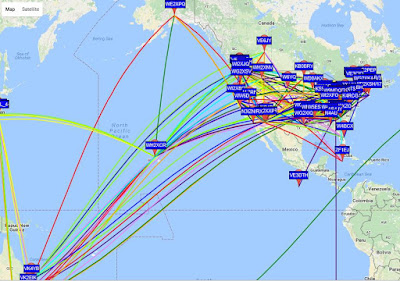 |
| courtesy: http://wsprnet.org/drupal/wsprnet/map |
Particularly striking was the long haul propagation from VK to North America, with northernmost VK4YB leading the pack. His 90 watt signal made it all the way to VE3IQB, near Ottawa as well as to NO3M, in Pennsylvania! To provide further hope to those that have little room for big receiving antennas, VE3IQB uses a typical small active e-probe antenna, 20' above ground!
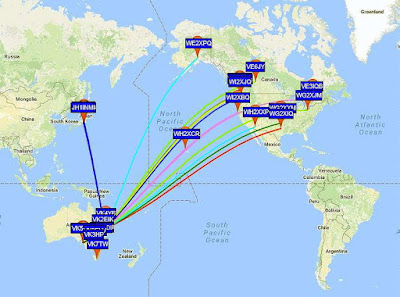 |
| courtesy: http://wsprnet.org/drupal/wsprnet/map |
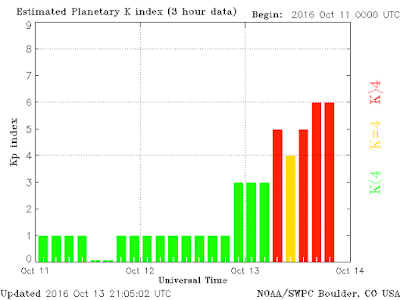 |
| courtesy: http://www.swpc.noaa.gov/ |
I'm theorizing that Roger's signal was arriving today at much lower angles than normal, evidenced by its far-reaching east coast reception and the fact that it couldn't get over my 600' local obstruction to the west. I've always believed that it takes higher angled signal arrival for me to hear Roger and today's events seem to support this.
Exactly what would cause this to be the case, I'll leave to the experts but I imagine that the sudden surge in geomagnetic activity played a significant role in today's very different propagation paths.
Roger was not the only VK lighting-up the map today. A much more detailed account of all the action can be found on the KB5NJD's daily 630m report here ... all very inspirational and hopefully enough to spur even more new activity on the MF band.
Why not give a listen and see what you can hear?
 VE3 – VE7 630m QSO
VE3 – VE7 630m QSO
The 630m band continues to provide interesting challenges for Canadian amateurs ... be they antenna, equipment or propagation related.
Sunday night produced another flurry of excitement on the new band, further demonstrating its potential for small stations operating from the suburbs.
On Sunday evening, VE3CIQ in Carleton Place, Ontario (southwest of Ottawa), and I, completed a two-way JT9 contact, following a short exchange of the required information (and more) just after midnight, Ontario time.
 |
| courtesy: https://www.google.ca/maps/ |
Noting the increased east-west favorability over the past few nights, Phil and I decided to give it a shot and were delighted to cover the 2200 mile / 3500km path while Murphy was sleeping and not messing with propagation.
Rather than randomly beacon on JT9, we both set 'calling each other' messages. Although this continued for some time, the QSO only took 12 minutes to complete once I started to decode Phil's signal out west. He had been decoding me and sending signal reports for a long time before his signal eventually peaked up here for the evening. I suspect that we could have continued the contact for the remainder of the night as his signal was getting stronger and stronger as we worked.
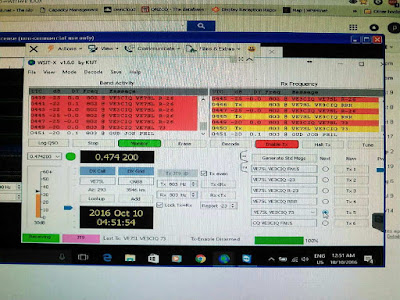 |
| Screen shot of QSO from VE3CIQ's end |
| VE3CIQ - 630m Station |
| VE3CIQ - Homebrew 630m Class-E Transmitter |
| VE3CIQ - 630m Linear-loaded Antenna |
Phil's station stands as yet another fine example of those living in the suburbs without a lot of room for antennas yet still able to successfully operate and explore our new 630m band. With a little ham-radio creativity, it's surprising how well a small station can perform, especially when the propagation co-operates.
Following our contact, I moved back to the WSPR section of the band and continued beaconing overnight.
Apparently Phil and I picked a good evening to run a sked as the overnight WSPR map shows it to have been the best night of the new DX season so far, with forty-four individual stations reporting my signal via the WSPRnet website.
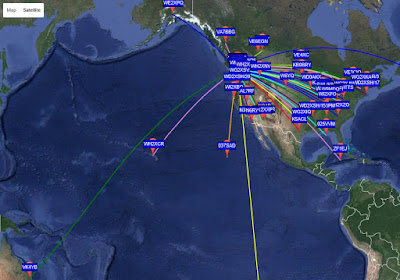 |
| courtesy: http://wsprnet.org/drupal/ |












